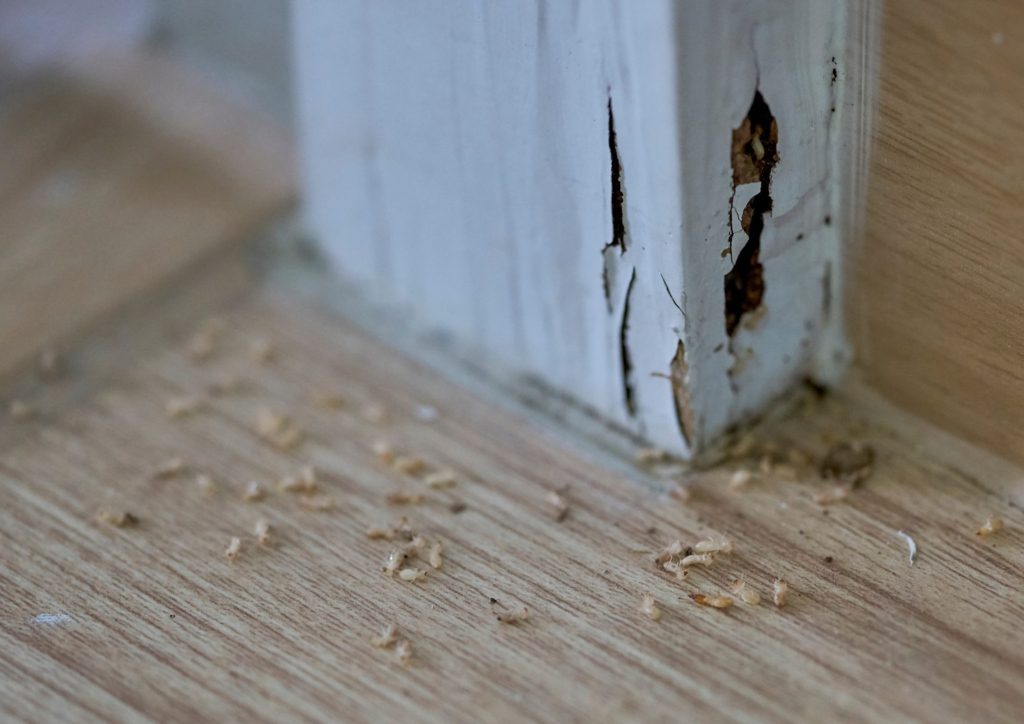
Termite infestations can sometimes be hard to detect because these pests often remain hidden within walls or structures’ foundations. However, recognizing certain key signs can help identify an infestation early and mitigate potential damage. Here are some of the indications that your home might be infested with termites:
Mud Tubes
Subterranean termite build pencil-sized mud tubes from the ground to their food source to maintain a humid and temperature-controlled environment. These tubes are usually found near the foundation of the house or in crawl spaces.
Termites Wings
Reproductive termites, or swarmers, have wings and fly to start new colonies. After swarming, they shed their wings. If you find piles of small, discarded wings in areas like windowsills, doors, or in cobwebs, it could indicate a termite infestation.
Termite Droppings
Drywood termites produce wood-colored or darker droppings known as frass. You might notice small piles of frass near wooden items or structures
Hollow-Sounding Wood
Termites prefer to stay hidden and they typically consume wood from the inside, which can leave the exterior looking relatively normal while the inside is hollowed out. If you come across wood in your home that sounds hollow when tapped or that is visibly damaged or crumbling, it could be a sign of termites.
Visible Damage
Another sign of a termite infestation is bubbling or uneven paint on the walls, which can be a sign of termites tunneling within or moisture buildup due to their activities. Furthermore, if you notice any unexplained fraying or damage to wires and cables in your home, termites could be the cause. They often gnaw through these materials, mistaking them for wood.
Swarms
A visible sign of a possible termite infestation is the presence of swarmers, which are the winged reproductive termites. They are often mistaken for winged ants. Seeing these swarmers inside your home could be an indication of an infestation.
Tight-fitting Doors and Hard-to-Open Windows
As termites devour wood, their excrement or ‘mud’ creates a protective environment that traps heat and moisture. This can cause timber to swell, making it harder to open doors and windows.
Weakened or Drooping Fronds
If your palm tree starts showing signs of stress, like drooping, yellowing, or falling fronds, it might be due to a termite infestation weakening the structure of the tree.
White ants
If you notice small, white, ant-like creatures in your home or yard, they could potentially be termites. This is especially true if they are found near wood or within mud tubes along your home’s foundation. However, it’s important to note that termites and ants are two distinct species with different behaviors and characteristics.
Termites and ants both have winged reproductive members in their colonies, known as alates or swarmers, which fly out to mate and establish new colonies. These swarmers are often mistaken for each other, but there are key differences:
Body Shape: Ants have a clearly defined head, thorax, and abdomen with a narrow, pinched waist. Termites, on the other hand, have a straight body without a clear waist.
Wings: Both ants and termites have two pairs of wings. However, an ant’s front pair of wings are longer than the rear pair, while a termite’s wings are all of equal length.
Antennae: Ants have elbowed antennae, while termites have straight antennae.
If any of these signs become evident in your home, it’s crucial to act swiftly. The quicker you respond, the more potential damage you can avert. You might be inclined to implement a DIY solution discovered online or purchase an over-the-counter termite product, but this can often prove to be a false economy. Homemade remedies are usually not potent enough, and retail products are often diluted versions of what professionals use. Effective termite treatment could demand hundreds of gallons of a specialized solution, so ironically, you may end up spending more on DIY attempts than if you had opted for professional intervention from the start.




